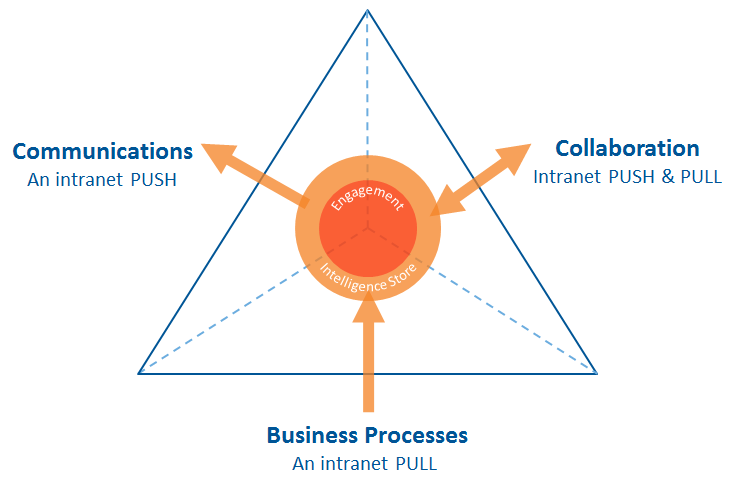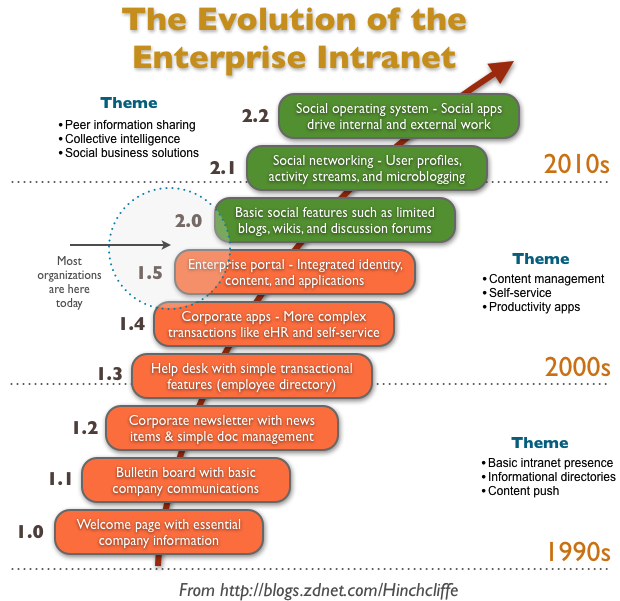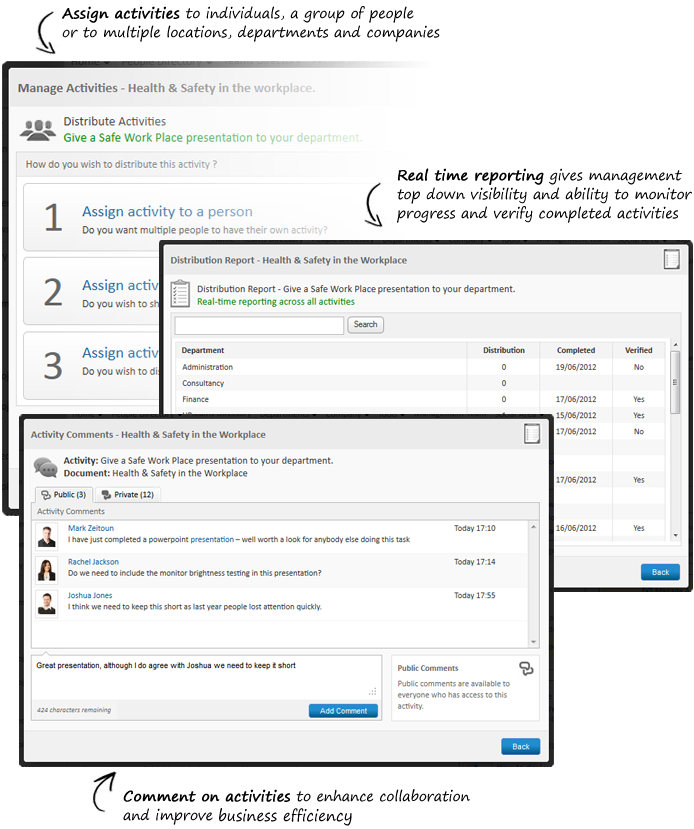The essential intranet blend
We spend countless hours at Interact chatting about what makes an intranet essential. We discuss our customers and the amazing intranets we’ve delivered over the last 10 years and think about what makes them tick.
So what do I mean by an essential intranet and how do we define this?
An essential intranet is one that a company depends on to carry out critical business processes. We define this as one that mixes the right blend of communications, business processes and collaboration (or social if you’re feeling brave) to achieve ultimate intranet success.
The amount of each element required in an essential intranet shouldn’t be fixed – it should constantly evolve just as the nature of business does itself. Some businesses may have a larger section of collaboration, some may have more communication – it’s about finding the right blend of all three components that is suitable for your organisation.

Let’s look at this in detail.
Communications
Intranets were born to deliver content. Back in 1996/1997 the fundamental aim was for them to be a central hub in an organisation where employees could view the latest news and policies. This has worked successfully over the years and although it’s rarely the sole function of a modern day intranet, it still forms part of its makeup as it is a way of pushing important content to employees. For example, the HR department will always need a central place to publish a new policy or procedure – information that needs to be pushed to employees.
Business Processes
I recently attended the J Boye conference in Philadelphia and was present in a great informal session on ‘Intranet Killer Apps’ run by Lau Andreasen (see my blog entry). Intranet Managers from across the globe were discussing what ‘the killer apps’ were on their intranet. What was driving the traffic and what did the employees rave about? Not surprisingly these apps were very business process orientated with examples such as booking rooms, processing expenses, requesting holiday and even ordering their lunch (often the most essential!)
There’s no doubt business processes will continue to be a significant part of intranets in the future. These pull users into the intranet – they come because they need it to carry out a critical business process that can’t be carried out without the use of the intranet.
Collaboration
Collaborating on an intranet by introducing social tools has rapidly been gaining momentum over the last 4/5 years. From simple features such as blogs and forums back in 2008/2009 to more engaging tools in today’s intranets such as teams, @ & # tagging, micro-blogging, feeds and gamification.
Discover more about the three elements needed for an essential intranet and discover the role your intranet plays in the technically advancing workplace in our free webinar with digital communications specialist and author of ‘The Digital Workplace – how technology is liberating work’, Paul Miller.
Although published in 2010 this diagram by Dion Hinchcliffe still provides a useful insight how the intranet landscape has changed. This shift to social has grown and grown. Many organisations now use social software in some form on their intranet (present on 87% of organisation intranets, according to the findings of the Intranet 2.0 Global Study.)

As the study reveals, even though the organisations have the tools, they have not yet deployed them enterprise wide. In fact fewer than 10% of organisations have a truly social intranet that incorporates social media at most levels and encourages the use of these tools by all employees.
This will change however as evidence is published on their effectiveness in an organisation.
McKinsey and Company has reported that the revenue growth of social businesses is 24% higher than less social firms and data from Frost and Sullivan backs that up across various KPIs.
Jacob Morgan also unearthed a new Frost and Sullivan report that has interesting data about collaborative tools concluding that: Companies that deployed collaboration tools saw improved performance in innovation (68% vs 39% that didn’t deploy), sales growth (76% vs 50% that didn’t deploy), and profit growth (71% vs 45% that didn’t deploy.)
Social intranet tools are now really starting to gain traction. Employees want to communicate in tools that are familiar to them. We all know about generation Y (http://en.wikipedia.org/wiki/Generation_Y) and their expectations on how to communicate are moving into the business world. For example, who uses email these days to organise a night out?
The Essential Intranet Blend
At Interact we believe that the correct blend of the three components – communication, business processes and collaboration, creates an essential intranet. This blend of course is different for every organisation.
We have experienced this first hand at Interact. For example, many organisations when launching their intranet often hold back on the social technologies. Their blend at launch could almost be described as traditional with a mix of push communication, business processes (i.e. eforms) and a little sprinkling of social such as document comments and blogging.
This blend then changes over time and adapts as the intranet grows, develops and gains traction. Employees adapt to the social technology, they begin to collaborate to solve business problems and share best practice and suddenly this technology goes from a ‘nice to have’ to essential. Unlike other tools, Interact Intranet allows organisations to introduce social tools at their own pace and grow as required.
Intelligent Blend
So now that we have our blend, how do we combine the three? At Interact we’ve long believed that intelligent intranet is the future of intranet technology. As previously mentioned in Nigel Danson’s CMSWire post pushing relevant content to users dramatically improve intranet engagement.
The intelligent store and intelligent features in Interact Intranet link the three methodologies together in many ways.
For example, in the recently released version 5.1 of Interact Intranet, we’ve launched a fantastic new application called Activity Management. This really focuses on linking all three elements.
Activity Management offers a unique way of distributing activities to individuals or groups within an organisation. Built around documents (traditionally push), this module gives managers and head office staff full transparency on how employees are progressing with activities and quickly identifies quickly identifies if deadlines are not being achieved.

As well as employees being able to easily see their list of assigned activities using the Activity app on their intranet homepage, they are able to comment on their progress, publicly or privately, and feedback once the activity has been completed.
By allowing people to collaborate around activities – efficiency is increased and problems are solved faster, helping to create a successful social intranet that solves business issues through collective intelligence.
This application intelligently combines:
- Communication –using documents traditionally used as push content
- Business processes –the activities being assigned to an employee or group to get work done
- Collaboration –the ability for employees to collaborate and share best practice
It’s the types of tools that combine these concepts which will assist companies in their quest to achieve an essential intranet.
Analogy Time:
Think about coffee for a moment – not so long ago coffee (in the UK at least) consisted of freeze-dried granules from a glass jar, mixed with a hot water and dash of milk. It did the job – a hot beverage that kept you alert. This is how I think of traditional intranets many years ago – a ‘flat white coffee.’
How things have evolved today. We now have an entire coffee menu and coffee machine’s which blend our perfect coffee (get the ‘blend’now?). It’s still a hot drink that keeps you alert but it has been blended to produce an even better coffee that is personalised for you. Just as an essential intranet today has elements that are blended together to produce an intranet that is the life-blood of the organisation.
Discover more about the three elements needed for an essential intranet and discover the role your intranet plays in the technically advancing workplace in our free webinar with digital communications specialist and author of ‘The Digital Workplace – how technology is liberating work’, Paul Miller.
